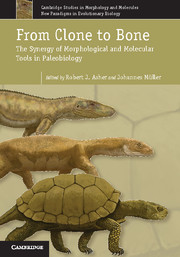Book contents
- Frontmatter
- Contents
- Contributors
- 1 Molecular tools in palaeobiology: divergence and mechanisms
- PART I Divergence
- 2 Genomics and the lost world: palaeontological insights into genome evolution
- 3 Rocking clocks and clocking rocks: a critical look at divergence time estimation in mammals
- 4 Morphological largess: can morphology offer more and be modelled as a stochastic evolutionary process?
- 5 Species selection in the molecular age
- PART II Mechanisms
- 6 Reconstructing the molecular underpinnings of morphological diversification: a case study of the Triassic fish Saurichthys
- 7 A molecular guide to regulation of morphological pattern in the vertebrate dentition and the evolution of dental development
- 8 Molecular biology of the mammalian dentary: insights into how complex skeletal elements can be shaped during development and evolution
- 9 Flexibility and constraint: patterning the axial skeleton in mammals
- 10 Molecular determinants of marsupial limb integration and constraint
- 11 A developmental basis for innovative evolution of the turtle shell
- 12 A molecular–morphological study of a peculiar limb morphology: the development and evolution of the mole's ‘thumb’
- 13 Manus horribilis: the chicken wing skeleton
- Index
- Plate-section
- References
5 - Species selection in the molecular age
Published online by Cambridge University Press: 05 November 2012
- Frontmatter
- Contents
- Contributors
- 1 Molecular tools in palaeobiology: divergence and mechanisms
- PART I Divergence
- 2 Genomics and the lost world: palaeontological insights into genome evolution
- 3 Rocking clocks and clocking rocks: a critical look at divergence time estimation in mammals
- 4 Morphological largess: can morphology offer more and be modelled as a stochastic evolutionary process?
- 5 Species selection in the molecular age
- PART II Mechanisms
- 6 Reconstructing the molecular underpinnings of morphological diversification: a case study of the Triassic fish Saurichthys
- 7 A molecular guide to regulation of morphological pattern in the vertebrate dentition and the evolution of dental development
- 8 Molecular biology of the mammalian dentary: insights into how complex skeletal elements can be shaped during development and evolution
- 9 Flexibility and constraint: patterning the axial skeleton in mammals
- 10 Molecular determinants of marsupial limb integration and constraint
- 11 A developmental basis for innovative evolution of the turtle shell
- 12 A molecular–morphological study of a peculiar limb morphology: the development and evolution of the mole's ‘thumb’
- 13 Manus horribilis: the chicken wing skeleton
- Index
- Plate-section
- References
Summary
Introduction
Everything biological varies. Without variation, evolution would not be possible. This is a truism in macroevolution as much as it is within and between organisms. Species vary in their phenotypic and macroecological traits (Brown 1995) and variation also exists in the taxonomic rates of speciation and extinction over time (Alroy 2008), among taxa (Van Valen 1973; Sepkoski 1981; Raup and Boyajian 1988), and within taxa (Van Valen 1973, 1975; Liow et al. 2008; McPeek 2008; Simpson and Harnik 2009; Simpson 2010). Variation in diversification rates produces the major patterns of diversification we observe in the fossil record. Understanding the patterns and causes of variation in diversification rates has been the focus of palaeobiology for decades (Simpson 1944, 1953; Van Valen 1973; Raup 1978; Gould and Calloway 1980; Sepkoski 1981; Raup 1991a, 1991b).
Palaeobiologists, however, are not the only ones interested in understanding the patterns and causes of diversification. Diversification is also interesting to ecologists for at least two reasons. Major spatial patterns of diversity such as the latitudinal diversity gradient are likely to be underpinned by historical patterns of speciation and extinction (Jablonski and Hunt 2006; Krug et al. 2007, 2008; Kiessling et al. 2010). Also, many distributions of ecologically important traits, for example body size, may be, in part, a product of the historical patterns of differential diversification (Stanley 1975; Van Valen 1975). The second interest is the issue of diversity limitation. Data from the fossil record and molecular phylogenetics of extant organisms have been brought in to study this issue and evidence is accumulating that diversity is, in fact, constrained (Cracraft 1982; Nee et al. 1992b; Paradis 1997; Pybus and Harvey 2000; Nee 2001; Ricklefs 2007; Alroy 2008, 2009, 2010; Alroy et al. 2008; McPeek 2008; Phillimore and Price 2008; Rabosky and Lovette 2008a, 2009b; Phillimore and Price 2009; Quental and Marshall 2009, 2010; Rabosky 2009b).
- Type
- Chapter
- Information
- From Clone to BoneThe Synergy of Morphological and Molecular Tools in Palaeobiology, pp. 116 - 134Publisher: Cambridge University PressPrint publication year: 2012
References
- 5
- Cited by



